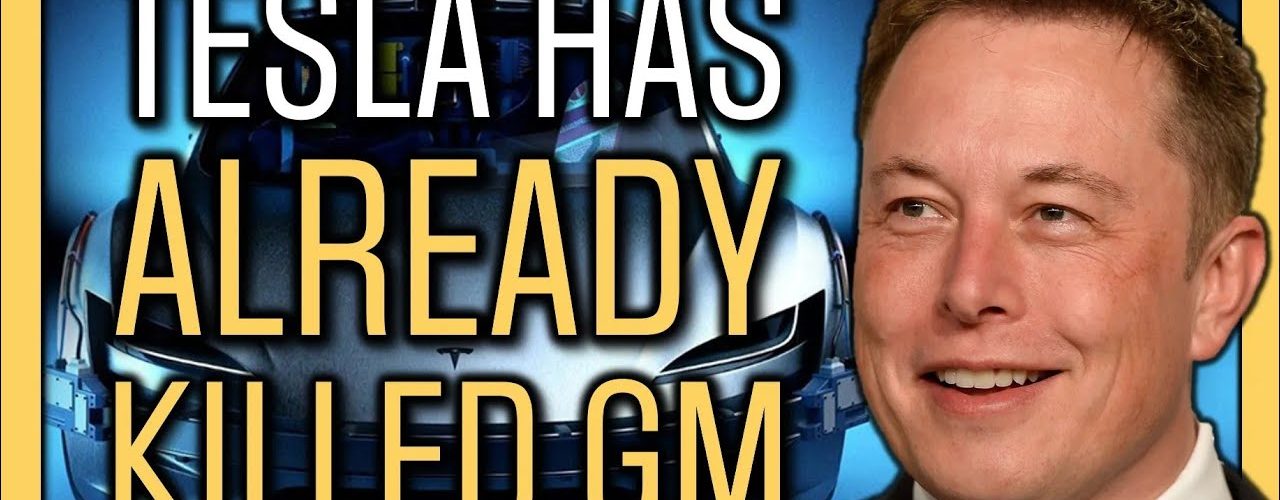Mentioned in Video:
- ⚡ Cathie Wood on Tesla: HUGE Growth & Historic Lead: ⚡ Cathie Wood on Tesla: HUGE Growth & Historic Lead: https://www.youtube.com/watch?v=qTKpjwuKgOI
- 🤯 The Great Collapse – Are YOU Prepared? | Investing in Disruption Starts With Understanding It: https://www.youtube.com/watch?v=kGgC1ryXZs0
- ⚠️ URGENT: Cathie Wood Says These Stocks Face a Deflationary Crash: https://www.youtube.com/watch?v=7BS-ok3pHes
- Rethinking Energy 2020-2030: 100% Solar, Wind, and Batteries is Just the Beginning (RethinkX – Dr. Adam Dorr): https://www.youtube.com/watch?v=6zgwiQ6BoLA
- Biden gives remarks at General Motors electric vehicle factory in Detroit: https://www.youtube.com/watch?v=XuWvsK3rNeM
- GM CEO: Company did ‘appropriate diligence' before Nikola deal (CNBC): https://www.youtube.com/watch?v=mpZS07a55OQ
- Support the channel and get extra member-only benefits by joining us on Patreon: https://www.patreon.com/tickersymbolyou
⚡ #TSLA (Tesla stock) is reacting to a larger pattern than we think. Many stock market forces are coming together to prop up #GM stock. For example, @General Motors says they plan to go fully electric by 2035. U.S. President Joe Biden says Mary Barra, GM CEO, electrified the auto industry. Did we all forget that GM bought an 11% stake in @Nikola Motor Company (NKLA stock) – or is this part of a larger pattern? In this episode, I'll show you the hidden numbers behind every Tesla stock prediction saying it's one of the best stocks to buy now and how GM's fate is already sealed.
Video Transcript:
00:00
this is a somber episode for me not just
00:02
because i'm dressed for a funeral but
00:04
also because i have a confession to make
00:06
i haven't been giving you the full story
00:08
on disruptive innovation as bullish as i
00:11
am on e-commerce i'm actually just as
00:13
bearish on most physical stores as
00:15
bullish as i am on fintech and crypto
00:17
i'm actually just as bearish on
00:18
middlemen and legacy banks as bullish as
00:21
i am on electric vehicles i'm just as
00:23
bearish on gas powered cars and in my
00:26
effort to make this a fun upbeat and
00:28
positive channel i've spent most of my
00:29
time talking about innovators like tesla
00:32
and not enough time talking about the
00:33
companies they're going to disrupt most
00:36
people have never seen exponential
00:37
growth the returns are going to be
00:39
phenomenal and for any corporations who
00:43
are listening to that or other
00:44
businesses
00:46
you need to embrace these new
00:47
technologies because they're going to be
00:49
transformational and if you don't
00:51
embrace them
00:53
you're not going to win in fact you may
00:55
not be around in this episode i'm going
00:58
to give you the full story i'll use
01:00
tesla and gm as an example but the
01:02
concepts i'll talk about extend to
01:04
almost every industry and market sector
01:06
i'll share a few hidden numbers that
01:08
secretly separate the winners from the
01:10
losers the disruptors from the disrupted
01:13
because the truth is you can't talk
01:14
about one without the other since they
01:16
compete for the same customers the same
01:18
talent and the same investors even
01:20
beyond that one technology can come in
01:22
and disrupt many different markets think
01:25
about how many products and services no
01:26
longer exist because there are now apps
01:28
on your smartphone all of which were
01:31
many billion dollar markets just a few
01:33
years ago poof gone and that's just your
01:36
smartphone now think about all the other
01:38
legacy technologies and systems that big
01:41
businesses like gm have spent billions
01:43
of dollars on decades ago and have been
01:46
piecing together ever since if the
01:48
smartphone alone replaced all this can
01:50
you imagine how many trillions of
01:52
dollars of products and services will be
01:54
disrupted by the likes of artificial
01:56
intelligence blockchain technology
01:58
advanced robotics gene sequencing and
02:00
editing and modern energy storage
02:02
solutions not to mention the products
02:04
and services that will combine them that
02:07
disruption measures in the tens of
02:09
trillions of dollars and because of
02:11
disruptions like these apple's market
02:12
cap is pushing three trillion dollars
02:15
today and tesla's is at already near one
02:17
trillion dollars again with that context
02:20
here's a little more of that intro clip
02:21
of kathy wood from her most recent
02:23
episode of in the know most people have
02:26
never seen exponential growth and they
02:28
certainly haven't seen convergence of
02:31
exponential growth trajectories that we
02:34
see for example in autonomous taxi
02:37
networks the convergence of robotics uh
02:40
energy storage and artificial
02:42
intelligence so one s-curve feeding
02:43
another s-curve
02:45
we think that delivers 10 trillion
02:47
dollars in revenues in in year 10 10 20
02:50
30. now if that's right that's from zero
02:53
the returns are going to be phenomenal
02:55
we're not going back
02:57
and uh and therefore we think that you
03:00
should start thinking about these stocks
03:04
not as stay-at-home stocks
03:07
but stay connected stocks stay
03:10
competitive stocks
03:12
stay globally competitive stocks
03:15
because that's what we do
03:17
we're focused on the way the world's
03:19
going to work
03:21
and
03:22
really transformational growth and for
03:24
any corporations who are listening to
03:27
that or other businesses
03:29
you need to embrace these new
03:31
technologies because they're going to be
03:32
transformational and if you don't
03:35
embrace them
03:37
you're not going to win in fact you may
03:39
not be around in my opinion kathy wood
03:41
is spot on when she says that companies
03:43
who don't embrace these technologies may
03:45
not survive in my very first episode i
03:48
said that arc invest will keep making
03:49
history because they understand it
03:51
better than anyone else and throughout
03:53
history the cycle of innovation
03:55
disruption and creative destruction
03:57
happens again and again and again
04:00
what is creative destruction i've
04:02
actually already explained it to you
04:04
it's what the smartphone did to mp3
04:05
players and handheld gps systems and
04:08
barcode scanners and stopwatches it's
04:10
what the automobile did to the
04:11
horse-drawn carriage and not just the
04:13
horse-drawn carriage but every other
04:15
piece of the logistics chain that
04:17
involves moving people and goods roads
04:19
changed to support cars buildings
04:21
changed to support the loading and
04:23
unloading of huge trucks infrastructure
04:25
changed to support traffic and refueling
04:28
and commercial fleets the world changed
04:30
and the companies that didn't change
04:32
with it did not survive by the way the
04:34
market for automobiles today is well
04:36
over 10 times bigger than the market for
04:38
the horse-drawn carriage was at its peak
04:40
and the companies that did change with
04:42
the times enjoyed massive returns for
04:44
doing so the same can be said with the
04:46
smartphone market compared to all of the
04:48
single-use products and services that
04:50
they've already destroyed over time so
04:52
the obvious next question is why are
04:55
these disruptions so obvious in
04:56
hindsight while being so hard to predict
04:59
in the future
05:00
why are no other wall street analysts
05:02
forecasting the same kind of creative
05:04
destruction when they compare a company
05:06
like tesla to a company like gm to
05:08
answer that here's a quick clip of dr
05:10
adam dorr director of research at
05:13
rethinkx explaining why analysts often
05:15
miss this big picture using battery cost
05:18
declines as an example lithium-ion
05:20
batteries are even more impressive 87
05:23
since 2010 averaging nearly 20 per year
05:26
and we project 15 improvement during the
05:28
2020s totaling another 80 percent by
05:31
2030 for an astounding 45 x improvement
05:35
in two decades
05:37
now conventional analyses almost always
05:39
underestimate cost improvements during
05:41
disruption costs improve as market
05:44
supply and demand expand and the
05:46
industry learns from experience
05:48
when conventional analyses often make
05:50
linear forecasts for market growth
05:52
in reality disruption always follows an
05:55
s-curve so one s-curve feeding another
05:58
s-curve
05:59
so the big thing analysts are getting
06:01
wrong is that they're making linear
06:02
assumptions about the future while
06:04
disruptions always follow an s-curve
06:07
what is an s-curve this is where those
06:09
hidden numbers come in let me break it
06:11
down for you there's something called
06:12
wright's law which says that for every
06:14
cumulative doubling in production
06:16
technology costs will decline by a fixed
06:18
percentage every time we double the
06:20
number of batteries produced that same
06:22
battery should cost about 20 percent
06:24
less than it used to which looks like an
06:27
exponential decline if you were to plot
06:29
battery costs over time the hidden
06:31
number in this example is that the total
06:33
number of batteries produced roughly
06:35
doubled every year and it's that
06:37
doubling that caused costs to decline by
06:39
about 20 percent not just the passing of
06:42
time itself this exponential drop in
06:44
price is met with an even larger
06:46
increase in demand you already know this
06:49
as well for example if you cut the price
06:51
of a tesla model 3 in half way more than
06:54
twice as many people would buy one if
06:56
you were to cut the price of an iphone
06:57
by 75
06:59
almost everyone in the connected world
07:01
would get one if you were to cut the
07:02
price of a lithium-ion battery by 95
07:05
percent it would become a foundational
07:07
building block for almost every
07:08
technology that can run on one which is
07:10
pretty much exactly what happened over
07:12
the last two decades this exponential
07:14
relationship between lower prices and
07:17
increased demand has nothing to do with
07:19
electronics and everything to do with
07:21
economics it's called the price
07:23
elasticity of demand according to arc
07:25
invest research in the last 10 years
07:27
from 2008 to 2017 the price of an
07:30
industrial robot was cut roughly in half
07:32
from fifty thousand dollars per robot to
07:34
about twenty five thousand dollars but
07:36
the demand for those robots went up by
07:38
four x over that same time frame the
07:40
hidden number here is that sometime
07:42
between 2008 and 2010 industrial robots
07:46
became cheaper than hiring a human to do
07:48
certain tasks then and every year after
07:50
robots got better at doing more and more
07:52
tasks and cheaper per task they could do
07:55
so companies demanded even more of them
07:57
which started a big feedback loop of
07:59
robots getting cheaper and better and
08:01
other companies ordering even more of
08:03
them the lesson here is that it's not
08:04
enough just to be cheap in general you
08:07
have to be cheaper enough to replace the
08:09
customer's current working solution
08:11
specifically a toyota camry one of the
08:13
most popular cars in the world costs
08:15
about twenty five thousand dollars today
08:18
here is the cost decline curve for a
08:19
tesla model three comment below or tweet
08:22
me at ticker symbol u with what you
08:24
think will happen to the demand of the
08:26
tesla model 3 when it becomes cheaper
08:28
than the toyota camry i'm excited to
08:30
hear your thoughts you now have all the
08:32
ammo you need to understand this s-curve
08:34
that kathy wood and adam dorr are
08:36
talking about so here's the next clip
08:38
which explains what happens to the
08:40
companies that are sitting on the wrong
08:42
side of change the wrong side of the
08:44
same s-curve in reality disruption
08:47
always follows an s-curve
08:49
the first phase of which is exponential
08:52
and this is what we're seeing now the
08:54
global market for each of these three
08:56
technologies shows a beautifully
08:58
consistent exponential curve
09:02
so
09:02
why do disruptions follow an s-curve
09:06
for any new technology falling costs
09:09
increase demand which attracts more
09:11
investment in production that in turn
09:13
expands supply and expanding supply
09:15
lowers costs even further
09:17
at the same time growing demand also
09:19
triggers more infrastructure investment
09:21
and government support which also
09:23
increase supply
09:25
as supply expands the technology itself
09:27
improves
09:29
the public becomes more accepting of it
09:31
and network effects emerge around
09:32
leading brands and platforms all of
09:34
which drive demand growth even further
09:37
so the entire process is characterized
09:40
by acceleration with each feedback loop
09:43
amplifying the others in a virtuous
09:44
cycle and at the same time growing
09:47
demand for the new reduces demand for
09:49
the old
09:50
revenues for the old technology decline
09:53
which causes supply to shrink
09:55
a smaller supply means loss of economies
09:57
of scale and so costs increase
10:00
at higher costs which translate into
10:02
higher prices demand falls
10:05
less demand also means less profit less
10:08
investment in production and
10:09
infrastructure less government support
10:11
all of which cause supply to contract
10:13
further and that in turn reduces public
10:15
acceptance and weakens network effects
10:18
and so for incumbents the process is
10:21
also an accelerating one
10:23
where each factor catalyzes the others
10:25
but
10:26
in this case it's a vicious cycle of
10:28
decline
10:29
and less demand for the old drives all
10:31
the more demand for the new
10:33
now we've seen this pattern again and
10:36
again for technologies of all different
10:38
kinds throughout history and in each
10:40
case the outcome is not a slow
10:43
incremental transition
10:45
but rather a rapid and total
10:47
transformation of the market that takes
10:49
place over the course of just a decade
10:52
or so now because the rate of change is
10:54
slow in the early years it almost always
10:57
takes conventional analysts and
10:58
observers by surprise when disruption
11:00
gets going the history of technology
11:03
shows us that the exponential growth
11:05
phase tends to continue until the new
11:08
technology comprises about 75 percent of
11:11
its global market ultimate size now
11:14
because most disruptions make their
11:16
markets expand this means that the new
11:18
technologies often grow well beyond the
11:20
size of the old system
11:23
conventional forecasts get disruption
11:26
wrong
11:27
major industry forecasts have made
11:29
simple linear projections for the growth
11:30
of solar for example year after year for
11:34
20 years
11:36
now at the same time that disruption
11:38
creates a new system it also wipes out
11:40
the old system and this isn't
11:41
theoretical it has already begun with
11:44
coal in the united states
11:46
year after year these same industry
11:48
forecasts have been desperately trying
11:50
to save coal from collapse with wishful
11:52
thinking the first time i saw that clip
11:54
it changed the way i view the world
11:56
and by the way his wishful thinking
11:58
comment is a big part of what's
11:59
happening with companies like tesla and
12:01
gm in the stock market today just like
12:04
the wishful thinking going on in the
12:05
energy sector against renewables and in
12:07
the banking sector against digital
12:09
wallets and cryptocurrencies you don't
12:11
have to go very far to see this wishful
12:13
thinking in action here's a clear
12:15
example from one of the most powerful
12:17
people on the planet
12:18
and i can remember your dramatic
12:20
announcement
12:21
that by 2035 gm would be 100
12:25
electric you changed the whole story
12:27
mary wherever wherever you are
12:29
there you are
12:31
you did mary
12:34
you electrified the entire automobile
12:36
industry i'm serious
12:38
you lead
12:39
and it matters the problem is wishful
12:41
thinking like speeches and magazine
12:43
covers are a big part of what keeps
12:45
legacy companies afloat according to
12:48
queen technica which used publicly
12:49
available data overall u.s auto sales
12:52
were down 13 percent year over year last
12:54
quarter tesla sales were up 67 percent
12:58
compared to quarter three of 2019 so
13:00
just two years ago tesla sales are up
13:02
104
13:04
while overall auto sales are down 22
13:07
and just to be clear gm's brands are
13:09
chevy buick gmc and cadillac all of
13:12
which are towards the worst performing
13:14
parts of this list just last year gm
13:16
signed a 2 billion deal with nicola only
13:19
months before nikola's ceo trevor milton
13:21
got indicted for fraud gm ceo mary
13:24
barrow remember gm has made an agreement
13:27
with nicola taking an 11 stake in the
13:29
company regarding the comments from
13:31
hindenburg research basically accusing
13:34
nikola of being
13:36
you know fraudulent in their claims
13:38
about the trucks that they're building
13:40
and developing gm's mary barra said they
13:43
have done appropriate due diligence if
13:46
that was done before the nikola deal
13:49
also says that she believes that the
13:51
nicola deal gives gm size and scale so
13:54
they're standing beside nicola you
13:57
electrified the entire automobile
13:59
industry i'm serious
14:01
if these are the kinds of decisions that
14:02
gm's research and diligence lead them to
14:05
going electric tomorrow still wouldn't
14:06
save them from tesla which has been
14:08
electric since their founding in 2003.
14:10
here's a fun fact tesla's fremont
14:12
gigafactory actually used to be a former
14:15
gm factory decades ago whether the
14:17
person doing the wishful thinking is a
14:19
wall street analyst or the president of
14:21
the united states the end is always the
14:23
same even worse wishful thinking isn't
14:26
the only thing propping up the stocks of
14:28
these legacy companies these value traps
14:30
here are some other hidden numbers for
14:32
you the ones that kathy wood thinks are
14:34
coming together to make a value bubble
14:36
that could be as big as the dot-com
14:38
bubble in 2000
14:40
value has been screaming this year and
14:42
in fact nancy lazar of cornerstone macro
14:46
has likened what could happen now
14:50
to the flip side of y2k
14:54
in the tekken telecom bubble
14:57
value looked like it had two left feet
14:59
couldn't do anything right and it got
15:01
worse as time went on
15:04
and of course um
15:06
value was the big winner the very big
15:09
winner for years coming out of the tech
15:11
and telecom
15:13
bust
15:14
i think that the innovation stocks that
15:17
have been pummeled in here many of them
15:20
are a quarter to a third of where they
15:22
were earlier this year
15:25
i believe they are going to be the big
15:27
winners once we confirm that the
15:30
inflation is transitory that there's a
15:33
recession risk out there
15:35
and when there's a fear of a recession
15:38
value stocks get hit hard and i do
15:41
believe there is something to this and
15:43
when inflation gets hit
15:45
uh value stocks get hit hard um
15:49
and we also have a lot of behavior
15:52
especially during risk-off periods that
15:54
is informed by the past uh algorithms
15:57
just use past
15:59
in order to um
16:02
uh determine what to sell and what to
16:04
buy
16:04
and that certainly
16:06
is true this time algorithms are pretty
16:09
mindless when it comes to the future in
16:11
fact they don't incorporate anything
16:13
about the future and more than half
16:15
of uh the trading volume we believe
16:18
today
16:19
is algorithm driven a lot of market
16:22
factors come together to form a bubble
16:24
this big in this case it's the current
16:26
narrative around high inflation being
16:28
permanent the worries of a potential
16:30
recession on the horizon and mindless
16:32
robots being responsible for more than
16:34
half of all trading on u.s stock
16:36
exchanges by some estimates algorithmic
16:38
trading actually makes up closer to 60
16:41
of all trades on the market and now
16:43
we've come full circle because these
16:45
algorithms use the exact linear
16:47
assumptions this entire episode is
16:49
warning you against i don't know where
16:50
in this bubble we might be today or how
16:53
far value traps like gm stock will fall
16:55
when that bubble pops but what i do know
16:57
is that one day the people who program
16:59
these algorithms will catch on to all
17:01
these other factors i've talked about in
17:03
the auto industry and beyond and that's
17:05
why if you're still running on these
17:07
legacy technologies you're running out
17:09
of time by the way that funeral i'm
17:11
going to is for general motors
17:15
this is ticker symbol u my name is alex
17:18
reminding you that the best investment
17:20
you can make
17:21
is in your
17:23
[Music]
If you want to comment on this, please do so on the YouTube Video Here














